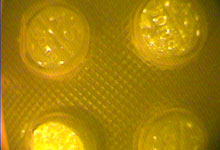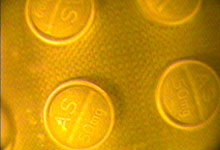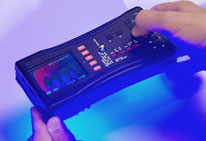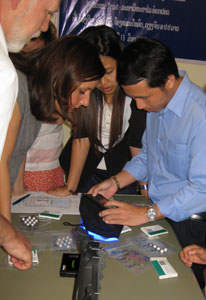FDA acts against compromised antimalarial drugs
May / June 2013 | Volume 12, Issue 3
To counteract a global surge in counterfeit and substandard drugs, including antimalarials, the U.S. Food and Drug Administration (FDA) has announced a partnership to make a simple, hand-held device available so developing countries can more easily test if drugs are authentic or not.


Photos by Nico Ranierie/FDA
The FDA has launched a partnership to make
available a tool that differentiates between
fake malaria drugs (top) and authentic drugs
(bottom).
In countries where malaria is endemic, falsified antimalarial medications are a growing threat. "Fake or substandard antimalarial drugs are particularly dangerous because the malaria parasite can kill a person in a matter of days and adequate, prompt treatment is necessary," said FDA Commissioner Dr. Margaret A. Hamburg. More than 660,000 people die from malaria each year, most of whom are children.
Not only do fake drugs risk patients' lives, Hamburg noted, but they cause "double damage" in allowing the malaria parasite to develop drug resistance through exposure to low doses of the active compound designed to kill it.
Recognizing the need for a tool to help inspectors identify diluted or falsified drugs, the FDA developed the Counterfeit Detection Device-3 (CD-3). The tool illuminates a product with a variety of light wavelengths to enable a visual comparison of an unverified product with an authentic sample. Inspectors need only minimal scientific or technical background to operate the device and can conduct testing in remote areas.
The partnership project brings together a number of public and private entities including Fogarty. To verify the tool's use in a low-resource setting, researchers will conduct a pilot study in Ghana at sites established by U.S. Pharmacopeia, then will expand testing to other locations. The CDC and NIH will provide technical expertise and the Skoll Global Threats Fund will financially support the endeavor. Included in the partnership is the USAID-led President's Malaria Initiative. In addition, Corning Incorporated will help refine and improve the device based on data from testing sites.

Photo courtesy of FDA
The Counterfeit Detection Device-3 (CD-3)
helps inspectors identify diluted or falsified
drugs.

Photo by Dr. Jim Herrington/Fogarty
The FDA has developed a hand-held,
battery-powered scanner that uses light
wavelengths to highlight irregularities in
antimalarial and other drugs.
"The development of the CD-3 and the formation of this important partnership are critical steps toward the FDA's goal of improving the global product safety net in order to protect consumers in the U.S. and worldwide," Hamburg noted.
Malaria has "pandemic potential" and counterfeit drugs would seriously hamper efforts to contain it, according to Skoll's Dr. Larry Brilliant. He said CD-3's breakthrough technology offers not only a way to fight poor-quality drugs, but could also lead to new point-of-care diagnostic tools to improve early diagnosis of malaria and other diseases. "The ability to scan a medication has much in common technologically with the ability to scan the results of a blood or sputum test to diagnose or verify the type of disease that a patient has," he said.
In a pilot study in Laos last year by the CDC and Fogarty, the tool was used to screen 200 samples of artemisinin. "The FDA's device was highly accurate in detecting falsified artemisinin," said Fogarty's Dr. James Herrington. "It highlighted differences in the pills' markings, coloring and distribution of the pharmacological compounds, as well as in packaging holograms and watermarks."
The agency has successfully used CD-3 in the U.S. since 2010 to identify corrupted drugs for conditions such as cancer, depression and erectile dysfunction, as well as screen for substandard contact lenses, cosmetics, cigarettes, food and medical devices.
"The proliferation of counterfeit or substandard drugs around the world is a major public health problem and the developing world is disproportionately affected," Hamburg said. "It is imperative to come up with a way to identify these products before they are ever given to patients."
More Information
To view Adobe PDF files,
download current, free accessible plug-ins from Adobe's website.